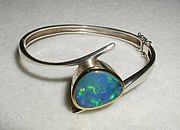Euro Bikini Girls 005
Pacific
Jewellery making in the Pacific started later than in other areas because of relatively recent human settlement. Early Pacific jewellery was made of bone, wood and other natural materials, and thus, has not survived. Most Pacific jewellery is worn above the waist, with headdresses, necklaces, hair pins and arm and waist belts being the most common pieces amongst island cultures. Jewellery made of flowers in Hawaii are called leis and are now commonly associated with that area and its relaxed, tourist friendly attitude.
Jewellery in the Pacific, with the exception of Australia, is worn to be a symbol of either fertility or power. Elaborate headresses are worn by many Pacific cultures and some, such as the inhabitants of Papua New Guinea, wear certain headresses once they have killed an enemy. Like the typical tribal cliché, many tribesman wear boar bones through their noses.
Island jewellery is still very much primal because of the lack of communication with outside cultures; some areas of Borneo and Papua New Guinea are yet to be explored by Western nations. However, the island nations which were flooded with Western missionaries have had drastic changes made to their jewellery designs. Missionaries saw any type of tribal jewellery as a sign of the wearer's devotion to paganism. Thus many tribal designs were lost forever in the mass conversion to Christianity.[28]
Australia is now the number one supplier of opals in the world. Although Australia wasn’t colonised until later on in history, it is now famous for its vast supplies of opals. Opals had already been mined in Europe and South America for many years prior, but in the late 1800’s, the Australian opal market entered as the dominant producer of opals. Australian opals are only mined in a few select places around the country, making it one the most profitable stones in the Pacific.[29]
One of the few cultures to today still create their jewellery as they did many centuries prior is the New Zealand Māori, who create Hei-tiki. The reason the hei-tiki is worn is not apparent; it may either relate to ancestral connections, as Tiki was the first Māori, or fertility, as there is a strong connection between this and Tiki. Another suggestion from historians is that the Tiki is a product of the ancient belief of a god named Tiki, perhaps dating back to before the Māoris settled in New Zealand. Hei-tikis are traditionally carved by hand from bone (commonly whale), nephrite or bowenite; a lengthy and spiritual process. The Hei-tiki is now popular amongst tourists who can buy it from souvenir or jeweller shops.
Other than jewellery created through Māori influence, jewellery in New Zealand remains similar to other western civilizations; multi cultural and varied. This is more noticeable in New Zealand because of its high levels of non-European citizens.[28]
Source from : http://en.wikipedia.org/wiki







No comments:
Post a Comment